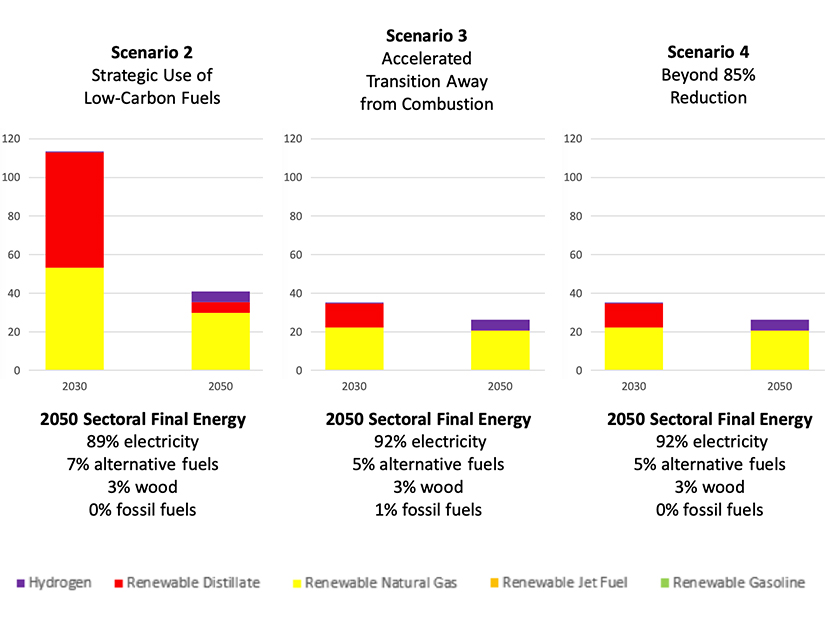New York’s Climate Action Council on Monday agreed to form new committees to help develop the state’s plans for reducing natural gas use, expanding alternative fuels and adopting economy-wide measures to cut emissions.
The CAC is holding public hearings through June 10 on its draft scoping plan that lays out steps needed to achieve the emission limits set by the Climate Leadership and Community Protection Act. The council has received 8,000 written comments and heard 200 people comment through four of 10 hearings, CAC Director Sarah Osgood said.
The original timeline to end the public comment period in mid-May proved unrealistic, she said. (See NY Officials Set 2022 Schedule for Climate Plan.)
“While others would prefer that the climate actions happen faster, we also heard concerns about affordability of electricity and the cost of the transition, specifically the cost associated with moving homes to all electric,” Osgood said. “A number of commenters expressed concerns about potential job losses among energy and utility workers and encouraged the council to take action that would ensure that the issue would be addressed.”
Administrators are planning to provide a distilled summary of the comments a month after the close of the comment period, Osgood said.
Committee Tasks
State officials and contractors presented outlines of what committees on gas system transition, alternative fuels and economy-wide measures could focus on in the coming months, with the council meeting at least monthly or more often as the workload increases over the summer, Osgood said.
The CAC will recruit volunteers for the committees to start meeting in May so the council can complete a final scoping plan by year-end that shows how the state will reduce economy-wide greenhouse gas emissions 40% by 2030 and no less than 85% by midcentury from 1990 levels, she said.
The gas transition will outline a coordinated plan to downsize the gas system, led by the Department of Public Service and supported by the New York State Energy Research and Development Authority (NYSERDA), Long Island Power Authority, New York Power Authority and the Department of Environmental Conservation.
The committee will consult with utilities, environmental justice groups and sectoral experts and draw upon successful plans in other jurisdictions, as will the alternative fuels committee in developing draft guidelines on the use of hydrogen, renewable natural gas and other biofuels.
DEC Deputy Commissioner Jared Snyder opened a discussion about the economy-wide committee, which will look at the certainty of emission reductions, the certainty of carbon price impacts on disadvantaged communities and affordability, and some competitiveness issues, such as the risk of leakage from carbon pricing.
NYSERDA will provide the council with analyses on existing carbon pricing knowledge and experience in other jurisdictions as well as the effects of a price on carbon specifically in New York, said Vladimir Gutman-Britten, assistant director of policy and markets.
“We want to share data on some of the key policy design choices in pursuing a system like this and the particular tradeoffs that might come with it,” Gutman-Britten said. “This analysis will help elucidate the impact of such a carbon tax on emissions and a variety of macroeconomic metrics, such as economy-wide energy spending, leakage of emissions and economic activity.”
State planners, he said, are not endorsing a policy of carbon pricing but choosing it because of limitations on modeling tools available, adding that “while we will be evaluating this one type of policy, we still think it would provide insights into how other approaches might work.”
Additional analysis may include potential effects of a large-scale investment program, including a sense of scale and the kinds of emissions reductions such a program might be able to yield under different spending choices, Snyder said.
The idea is “to unpack the kind of impact that pricing and an investment program might have on specific clean energy solutions … key technology things like EVs, heat pumps and things like that so we can better understand how the economics of those solutions change as a result of different policy choices the state will make,” Snyder said.
Kevin Hansen senior vice president and head of public policy at Empire State Development, the state’s main economic development agency, urged the economy-wide committee to continue “to think about impacts on businesses and workers and the issue of leakage.”

